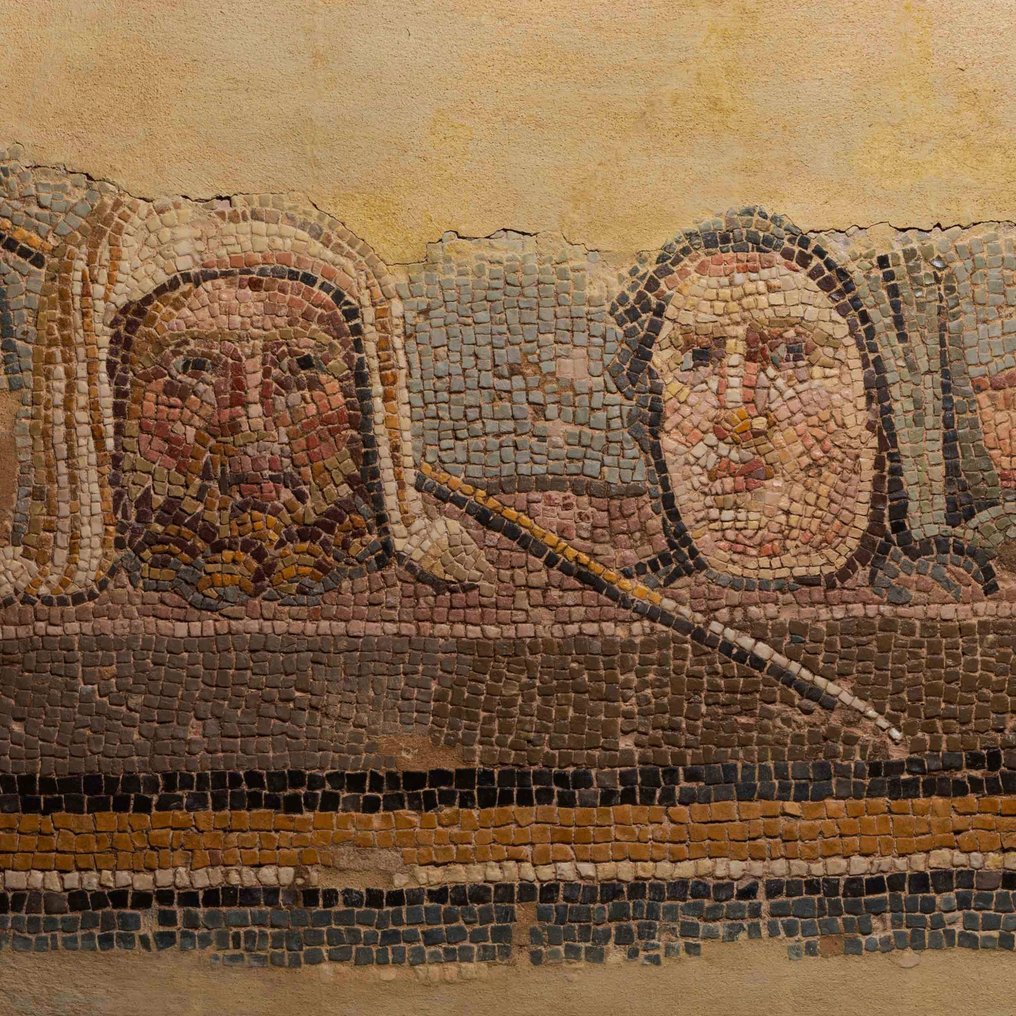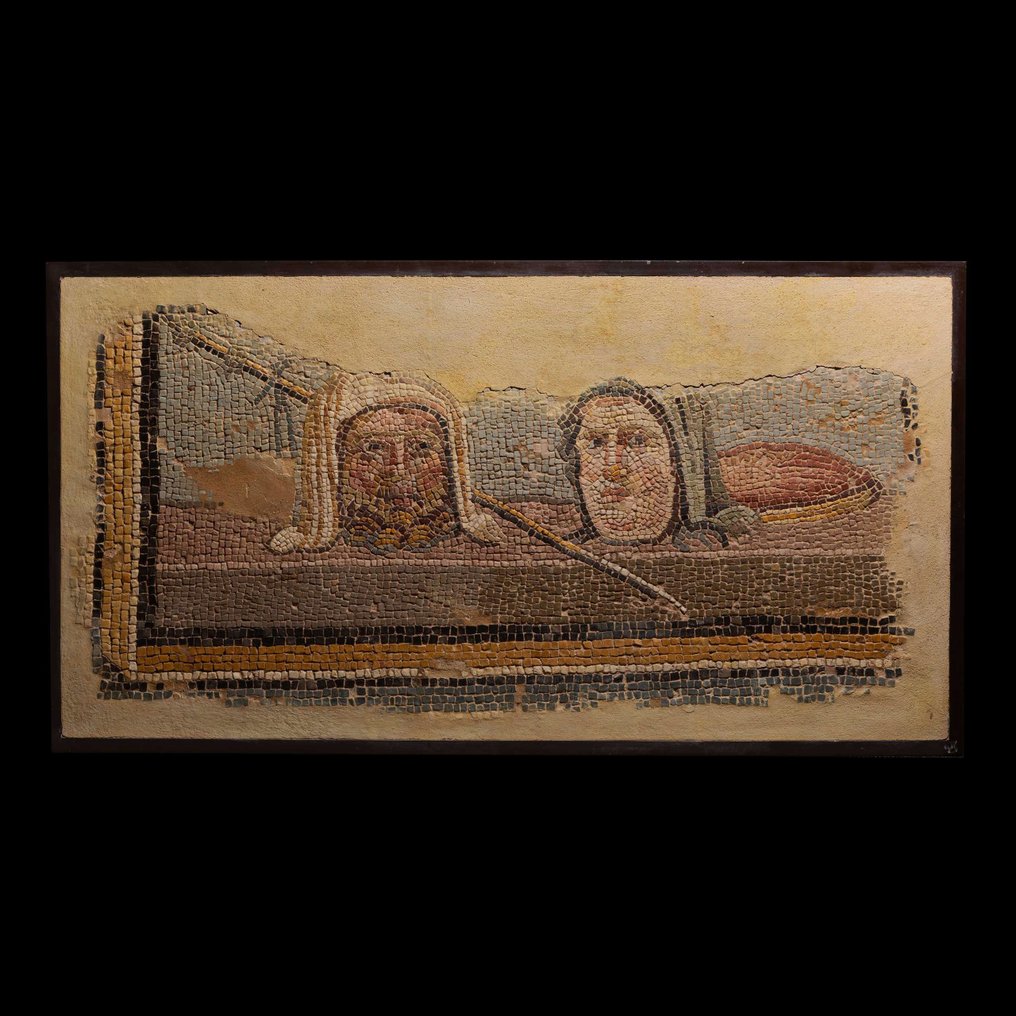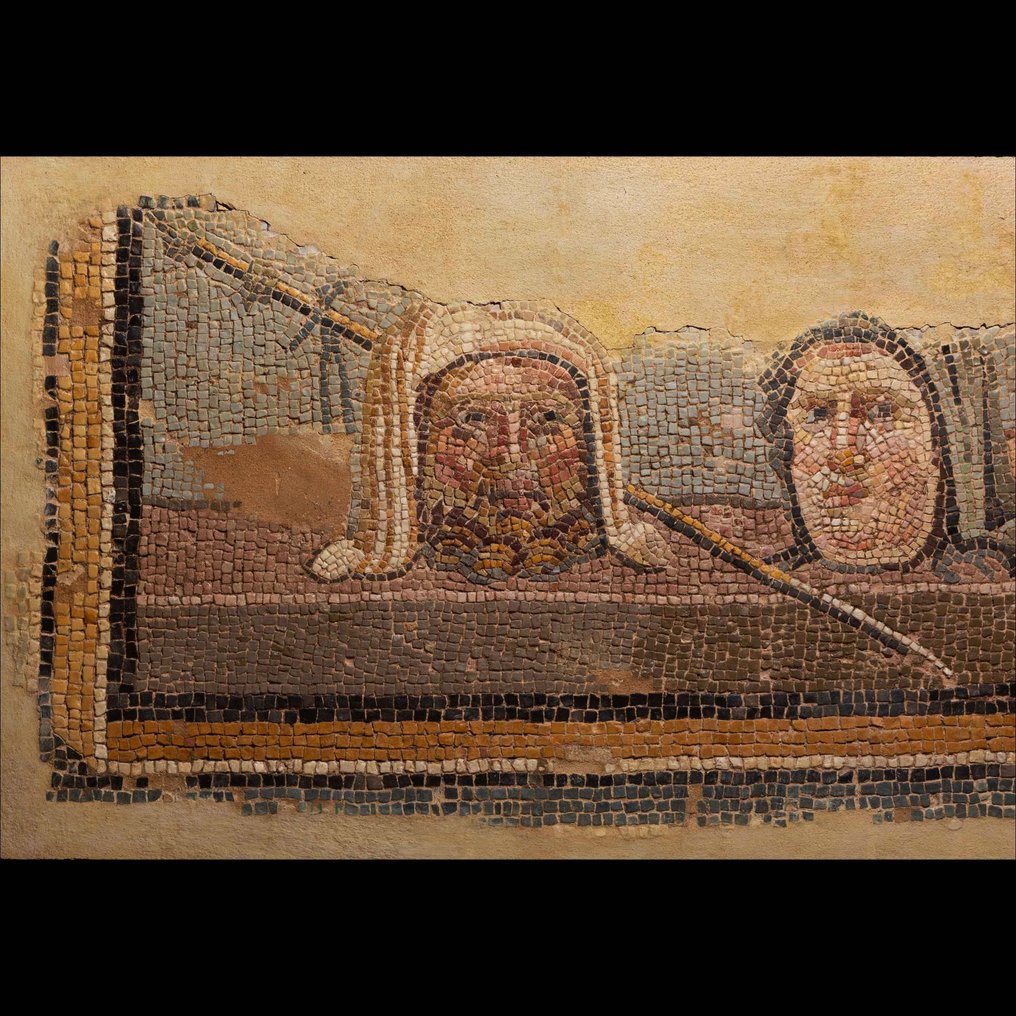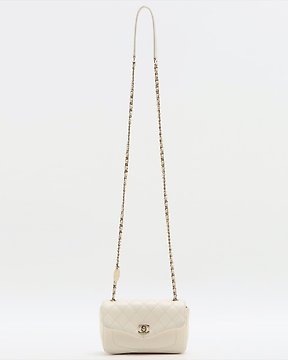Magnífica la entrega y el objeto. Perfecta la sonido del sibato
Vertaling bekijkenOud-Romeins Fragment van een mozaïek met de afbeelding van twee theatermaskers. 2e - 3e eeuw na Christus.
Nr. 88441893



Fragment of a Mosaic with the Image of two Theatrical Masks.
Roman Empire, 2nd - 3rd century AD.
MATERIAL: Marble tiles.
SIZE: Width 100 cm, height 47 cm. Frame: width 110 cm, height 59 cm.
PROVENANCE:
- Private collection, Malibu, California, USA, acquired before 1980.
- New York art market until 2023.
CONDITION: Good condition, mounting on modern support.
BIBLIOGRAPHY:
- DUNBABIN, K. Mosaics of the Greek and Roman world. Cambridge University Press. 1999.
- ÖNAL, M. Zeugma Mosaics. A Turizm Yayinlari. 2009.
PARALLELS:
Fig. 1 Mosaic with female figure, House of the Boat of Psyches. Antioch of the Orontes, Turkey, h. 200-225 AD, opus tessellatum. Musée du Louvre, Paris, inv. MND 1951, MA 3460.
Fig. 2 Mosaic with theatrical mask, House of the Faun. Pompeii, s. II BC, opus vermiculatum. Archaeological Museum Nazionale di Napoli (Italy), inv. 9994.
DESCRIPTION:
Fragment of Roman mosaic made following the opus tessellatum technique, with cubic marble tesserae that cover a wide chromatic range, allowing the flat areas of color to be combined with the light modeling of the faces, based on tonal gradations. This search for three-dimensionality in figurative motifs is typical of the Roman imperial mosaic (fig. 1), unlike the more symbolic and two-dimensional representation of the Byzantine period, where illusionistic modeling was preferably reserved for secondary plant, animal or architectural elements. .
The main motif is two theatrical masks, one male and one female, represented facing the viewer on a floor plane, accompanied by a staff decorated with ribbons and an oval object, perhaps a cushion or an inverted container. This design is framed by bands of flat color in black, white and ocher tones. In the central representation the palette is expanded, using different shades of white, red, yellow and brown to model the faces of the masks and other details, seeking a certain three-dimensional effect.
Theater masks are a common ornamental element in Rome, generally in relation to the Dionysian world and the values associated with it, ideas of a happy, pleasant, beautiful and joyful existence. They were therefore favorable elements for decorating the private sphere, which is why they will be found mainly in the gardens of Roman houses and villas as ornamental elements related to the celebration of life.
Usually, the representation of the theatrical mask in mosaic or fresco painting reproduces the real object used on stage, with the mouth open so that the actor's voice is projected (fig. 2). In this case, however, these are symbolic representations that do not seem to reproduce specific models of canonical theater characters, but directly the archetypes that they represent. The male mask is bearded, with a serene expression, and possibly represents the paterfamilias , the leader of the family and the house. At his side, the female character with a stern face and frown would represent his wife, the matron responsible for the proper functioning and harmony of the home.
The art of mosaic comes to Rome from Greece, and will soon constitute an entire industry, reaching levels of quality never seen before. Its diffusion was such that it became the main form of ornamentation of any Roman villa or house. In Rome, mosaics were built from small pieces called tesserae (hence the name opus tessellatum ), cubic-shaped pieces of calcareous rocks, glass or ceramic, of different sizes. These tiles were arranged on the surface to be decorated like a puzzle, distributing the color and shape according to the design, and were fixed with cement. A second technique, called opus vermiculatum , used tiles of different shapes, which adapt to the design.
At first, when the art of mosaic began to develop in Rome, it was used mainly to decorate ceilings or walls and rarely the floors, because it was feared that it would not offer sufficient resistance to footsteps. Once the technique was perfected, however, the necessary solidity was achieved to be able to apply it to floors, which favored the spread throughout the Empire of its use for the production of luxury flooring.
The growing importance of the mosaic industry is reflected in imperial regulations such as those carried out by Diocletian in the 3rd century, which established very precise price ranges, or by the facilities granted by Constantine to the Mosaists when he moved the capital of the Empire to Byzantium in the year 330, facilitating the exodus of Greek and Roman masters to the new capital and thus laying the foundations of the famous Byzantine mosaic.
Notes:
- The piece includes authenticity certificate.
- The piece includes Spanish Export License (Passport for European Union) - If the piece is destined outside the European Union a substitution of the export permit should be requested, can take between 1-2 weeks maximum.
- The seller guarantees that he acquired this piece according to all national and international laws related to the ownership of cultural property. Provenance statement seen by Catawiki.
#ExclusiveCabinetofCuriosities
De verkoper stelt zich voor
Fragment of a Mosaic with the Image of two Theatrical Masks.
Roman Empire, 2nd - 3rd century AD.
MATERIAL: Marble tiles.
SIZE: Width 100 cm, height 47 cm. Frame: width 110 cm, height 59 cm.
PROVENANCE:
- Private collection, Malibu, California, USA, acquired before 1980.
- New York art market until 2023.
CONDITION: Good condition, mounting on modern support.
BIBLIOGRAPHY:
- DUNBABIN, K. Mosaics of the Greek and Roman world. Cambridge University Press. 1999.
- ÖNAL, M. Zeugma Mosaics. A Turizm Yayinlari. 2009.
PARALLELS:
Fig. 1 Mosaic with female figure, House of the Boat of Psyches. Antioch of the Orontes, Turkey, h. 200-225 AD, opus tessellatum. Musée du Louvre, Paris, inv. MND 1951, MA 3460.
Fig. 2 Mosaic with theatrical mask, House of the Faun. Pompeii, s. II BC, opus vermiculatum. Archaeological Museum Nazionale di Napoli (Italy), inv. 9994.
DESCRIPTION:
Fragment of Roman mosaic made following the opus tessellatum technique, with cubic marble tesserae that cover a wide chromatic range, allowing the flat areas of color to be combined with the light modeling of the faces, based on tonal gradations. This search for three-dimensionality in figurative motifs is typical of the Roman imperial mosaic (fig. 1), unlike the more symbolic and two-dimensional representation of the Byzantine period, where illusionistic modeling was preferably reserved for secondary plant, animal or architectural elements. .
The main motif is two theatrical masks, one male and one female, represented facing the viewer on a floor plane, accompanied by a staff decorated with ribbons and an oval object, perhaps a cushion or an inverted container. This design is framed by bands of flat color in black, white and ocher tones. In the central representation the palette is expanded, using different shades of white, red, yellow and brown to model the faces of the masks and other details, seeking a certain three-dimensional effect.
Theater masks are a common ornamental element in Rome, generally in relation to the Dionysian world and the values associated with it, ideas of a happy, pleasant, beautiful and joyful existence. They were therefore favorable elements for decorating the private sphere, which is why they will be found mainly in the gardens of Roman houses and villas as ornamental elements related to the celebration of life.
Usually, the representation of the theatrical mask in mosaic or fresco painting reproduces the real object used on stage, with the mouth open so that the actor's voice is projected (fig. 2). In this case, however, these are symbolic representations that do not seem to reproduce specific models of canonical theater characters, but directly the archetypes that they represent. The male mask is bearded, with a serene expression, and possibly represents the paterfamilias , the leader of the family and the house. At his side, the female character with a stern face and frown would represent his wife, the matron responsible for the proper functioning and harmony of the home.
The art of mosaic comes to Rome from Greece, and will soon constitute an entire industry, reaching levels of quality never seen before. Its diffusion was such that it became the main form of ornamentation of any Roman villa or house. In Rome, mosaics were built from small pieces called tesserae (hence the name opus tessellatum ), cubic-shaped pieces of calcareous rocks, glass or ceramic, of different sizes. These tiles were arranged on the surface to be decorated like a puzzle, distributing the color and shape according to the design, and were fixed with cement. A second technique, called opus vermiculatum , used tiles of different shapes, which adapt to the design.
At first, when the art of mosaic began to develop in Rome, it was used mainly to decorate ceilings or walls and rarely the floors, because it was feared that it would not offer sufficient resistance to footsteps. Once the technique was perfected, however, the necessary solidity was achieved to be able to apply it to floors, which favored the spread throughout the Empire of its use for the production of luxury flooring.
The growing importance of the mosaic industry is reflected in imperial regulations such as those carried out by Diocletian in the 3rd century, which established very precise price ranges, or by the facilities granted by Constantine to the Mosaists when he moved the capital of the Empire to Byzantium in the year 330, facilitating the exodus of Greek and Roman masters to the new capital and thus laying the foundations of the famous Byzantine mosaic.
Notes:
- The piece includes authenticity certificate.
- The piece includes Spanish Export License (Passport for European Union) - If the piece is destined outside the European Union a substitution of the export permit should be requested, can take between 1-2 weeks maximum.
- The seller guarantees that he acquired this piece according to all national and international laws related to the ownership of cultural property. Provenance statement seen by Catawiki.
#ExclusiveCabinetofCuriosities
De verkoper stelt zich voor
- 825
- 10
- 1
very well packed with all the documents included, thnks
Vertaling bekijkenGreat object. Really beautiful. Quick delivery. Excellent.
Vertaling bekijkenSuperbe objet, Service d'Arqueologia Ancient Art excellent et rapide. Jaume Bagot toujours parfait .
Vertaling bekijkenTodo perfecto gracias
Vertaling bekijkenNice item all ok A+++
Vertaling bekijkenThank you for this Oinochoe, one question: did you as promised read my post!
Vertaling bekijkenVery cooperative in every aspect of the transaction.
Vertaling bekijkenAlways a great pleasure!
Vertaling bekijkenFine quality, good service. Thanks.
Vertaling bekijkenMuy amables, muy bien todo. Gracias
Vertaling bekijkenAlles bestens
Vertaling bekijkenexactly as described and shipped safely and punctually.
Vertaling bekijkenschnelle Lieferung sehr sichere Verpackung alles bestens
Vertaling bekijkentres bel objet je le recherchai depuis longtemps envoi rapide et protégé je pense qu'il y aura d'autres achats avec ce vendeur merci +++++++
Vertaling bekijkenEinfach nur toll
Vertaling bekijkenTodo perfecto
Vertaling bekijkenottimo
Vertaling bekijkenperfetto
Vertaling bekijkentop oggetto bellissimo grazie 💯💯💯💯💯💯 :-)
Vertaling bekijkenI bought this beautiful artifact together with artifact from Mr. Bagot but although it is clearly stated on his shipping page that when purchasing multiple artifacts i paid the double package costs
Vertaling bekijkenI bought this beautiful artifact together with artifact from Mr. Bagot but although it is clearly stated on his shipping page that when purchasing multiple artifacts i paid the double package costs
Vertaling bekijkenBel objet, bien emballé. Parfait.
Vertaling bekijkenwonderful faiece and very fast shipping.thanks a lot
Vertaling bekijkenJ Bagot es un profesional excelente. Sus artículos son de gran calidad, se incluye la documentación necesaria y el embalaje se realiza con esmero. Le recomiendo encarecidamente.
Vertaling bekijken- 825
- 10
- 1
Magnífica la entrega y el objeto. Perfecta la sonido del sibato
Vertaling bekijkenDisclaimer
De verkoper garandeert dat het object legaal is verkregen en kan dit bewijzen. Catawiki heeft de verkoper geïnformeerd dat hij/zij documentatie moet overleggen die vereist is volgens de wetten in hun land van verblijf. De verkoper garandeert dat hij/zij toestemming heeft om het object te verkopen/exporteren. De verkoper zal alle over het object bekende herkomstgegevens aan de koper verstrekken. De verkoper zorgt ervoor dat eventueel benodigde vergunningen zijn/zullen worden geregeld. De verkoper zal de koper onmiddellijk informeren over eventuele vertragingen bij het verkrijgen van dergelijke vergunningen.
De verkoper garandeert dat het object legaal is verkregen en kan dit bewijzen. Catawiki heeft de verkoper geïnformeerd dat hij/zij documentatie moet overleggen die vereist is volgens de wetten in hun land van verblijf. De verkoper garandeert dat hij/zij toestemming heeft om het object te verkopen/exporteren. De verkoper zal alle over het object bekende herkomstgegevens aan de koper verstrekken. De verkoper zorgt ervoor dat eventueel benodigde vergunningen zijn/zullen worden geregeld. De verkoper zal de koper onmiddellijk informeren over eventuele vertragingen bij het verkrijgen van dergelijke vergunningen.









